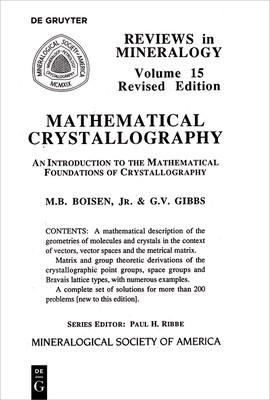
- We will send in 10–14 business days.
- Publisher: De Gruyter
- ISBN-10: 0939950197
- ISBN-13: 9780939950195
- Format: 15.6 x 23.4 x 2.7 cm, minkšti viršeliai
- Language: English
- SAVE -10% with code: EXTRA
Mathematical Crystallography (e-book) (used book) | bookbook.eu
Reviews
Description
Volume 15 of Reviews in Mineralogy is written with two goals in mind. The first is to derive the 32 crystallographic point groups, the 14 Bravais lattice types and the 230 crystallographic space group types. The second is to develop the mathematical tools necessary for these derivations in such a manner as to lay the mathematical foundation needed to solve numerous basic problems in crystallography and to avoid extraneous discourses. To demonstrate how these tools can be employed, a large number of examples are solved and problems are given. The book is, by and large, self-contained. In particular, topics usually omitted from the traditional courses in mathematics that are essential to the study of crystallography are discussed. For example, the techniques needed to work in vector spaces with noncartesian bases are developed. Unlike the traditional group-theoretical approach, isomorphism is not the essential ingredient in crystallographic classification schemes. Because alternative classification schemes must be used, the notions of equivalence relations and classes which are fundamental to such schemes are defined, discussed and illustrated. For example, we will find that the classification of the crystallographic space groups into the traditional 230 types is defined in terms of their matrix representations. Therefore, the derivation of these groups from the point groups will be conducted using the 37 distinct matrix groups rather than the 32 point groups they represent.
EXTRA 10 % discount with code: EXTRA
The promotion ends in 24d.00:31:28
The discount code is valid when purchasing from 10 €. Discounts do not stack.
- Publisher: De Gruyter
- ISBN-10: 0939950197
- ISBN-13: 9780939950195
- Format: 15.6 x 23.4 x 2.7 cm, minkšti viršeliai
- Language: English English
Volume 15 of Reviews in Mineralogy is written with two goals in mind. The first is to derive the 32 crystallographic point groups, the 14 Bravais lattice types and the 230 crystallographic space group types. The second is to develop the mathematical tools necessary for these derivations in such a manner as to lay the mathematical foundation needed to solve numerous basic problems in crystallography and to avoid extraneous discourses. To demonstrate how these tools can be employed, a large number of examples are solved and problems are given. The book is, by and large, self-contained. In particular, topics usually omitted from the traditional courses in mathematics that are essential to the study of crystallography are discussed. For example, the techniques needed to work in vector spaces with noncartesian bases are developed. Unlike the traditional group-theoretical approach, isomorphism is not the essential ingredient in crystallographic classification schemes. Because alternative classification schemes must be used, the notions of equivalence relations and classes which are fundamental to such schemes are defined, discussed and illustrated. For example, we will find that the classification of the crystallographic space groups into the traditional 230 types is defined in terms of their matrix representations. Therefore, the derivation of these groups from the point groups will be conducted using the 37 distinct matrix groups rather than the 32 point groups they represent.


Reviews